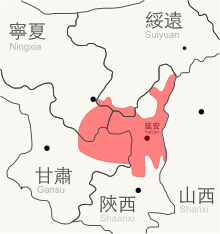Yan'an Soviet
You can help expand this article with text translated from the corresponding article in Chinese. (January 2022) Click [show] for important translation instructions.
|
| Shaan-Gan-Ning Border Region 陝甘寧邊區 | |
|---|---|
| Rump state of the Chinese Soviet Republic | |
| 1937–1950 | |
 Map of Shaan-Gan-Ning Border Region. | |
| Capital | Yan'an (1937–47, 1948-49) Xi'an (1949–50) |
| Area | |
• 1937 | 134,500 km2 (51,900 sq mi) |
| Population | |
• 1937 | 1,500,000 |
| Government | |
| Chairman | |
• 1937–1948 | Lin Boqu |
| Deputy Chairman | |
• 1937–1938 | Zhang Guotao |
• 1938–1945 | Gao Zili |
| Historical era | Chinese Civil War |
• Established | 6 September 1937 |
• Disestablished | 19 January 1950 |
| Today part of | China |
The Yan'an Soviet was a soviet governed by the Chinese Communist Party (CCP) during the 1930s and 1940s.[1] In October 1936 it became the final destination of the Long March, and served as the CCP's main base until after the Second Sino-Japanese War.[2]: 632 After the CCP and Kuomintang (KMT) formed the Second United Front in 1937, the Yan'an Soviet was officially reconstituted as the Shaan–Gan–Ning Border Region (traditional Chinese: 陝甘寧邊區; simplified Chinese: 陕甘宁边区; pinyin: Shǎn-Gān-Níng Biānqū; lit. 'Shaan-Gan-Ning Border Region').[a][3]
Organization
The Shaan-Gan-Ning base area, of which Yan'an was a part, was founded in 1934.[4]: 129
It was one of the two border region governments with the capital at Yan'an, and included parts of the provinces of Shaanxi, Gansu, Ningxia, and Suiyuan.[b] The other region was the Jin-Cha-Ji Border Area, which included parts of Shanxi, Chahar, and Hebei.
Although not on the front lines of the Second Sino-Japanese War, the Shaan-Gan-Ning Border Region was the most politically important and influential revolutionary base area due to its function as the de facto capital of the Chinese Communist Revolution.[5]: 129
Economy
The base area's economic situation was precarious.[4]: 129 It was difficult to support the growing communist army with the local peasant economy and the Nationalist blockade made it difficult to secure resources from outside the region.[4]: 129
The blockade decreased during the Second United Front, but the Nationalists intensified it after military hostilities began again in 1941.[4]: 129 Japanese assaults in the region and poor harvests worsened the effects of blockade and the region had a severe economic crisis in 1941 and 1942.[4]: 130 Some communist leaders raised the issue of abandoning the area, which Mao Zedong refused to do.[4]: 130 Mao implemented a mass line strategy to successfully address the crisis.[4]: 130
Media
The Eighth Route Army established its first film production group in the Yan'an Soviet during September 1938.[6]: 69 In 1943, the CCP released their first campaign film, Nanniwan, which sought to develop relationships between the CCP army and local people in the Yan'an area by showcasing the army's production campaign to alleviate material shortages.[4]: 16
Yuan Muzhi arrived in Yan'an in fall 1938.[4]: 128 With Wu Yinxian, Yuan made a feature-length documentary, Yan'an and the Eighth Route Army, which depicted the Eighth Route Army's combat against the Japanese.[4]: 128 They also filmed Norman Bethune performing surgeries close to the front lines.[4]: 128
Notes
- ^ Postal romanization: Shen–Kan–Ning. The name comes from the Chinese abbreviations of Shaanxi, Gansu, and Ningxia provinces.
- ^ Suiyuan is no longer a province; the area governed by the Yan'an Soviet that was part of Suiyuan is now part of Inner Mongolia.
References
- ^ "The Yan'an Soviet". 18 September 2019.
- ^ Van Slyke, Lyman (1986). "The Chinese Communist movement during the Sino-Japanese War 1937–1945". In Fairbank, John K.; Feuerwerker, Albert (eds.). Republican China 1912–1949, Part 2. The Cambridge History of China. Vol. 13. Cambridge University Press. pp. 609–722. doi:10.1017/CHOL9780521243384.013. ISBN 9781139054805.
- ^ Saich, Tony; Van De Ven, Hans J. (2015-03-04). "The Blooming Poppy under the Red Sun: The Yan'an Way and the Opium Trade". New Perspectives on the Chinese Revolution (0 ed.). Routledge. pp. 263–297. doi:10.4324/9781315702124. ISBN 978-1-317-46391-7. OCLC 904437646.
- ^ a b c d e f g h i j k Qian, Ying (2024). Revolutionary Becomings: Documentary Media in Twentieth-Century China. New York, NY: Columbia University Press. ISBN 9780231204477.
- ^ Opper, Marc (2020). People's Wars in China, Malaya, and Vietnam. Ann Arbor: University of Michigan Press. doi:10.3998/mpub.11413902. hdl:20.500.12657/23824. ISBN 978-0-472-90125-8. JSTOR 10.3998/mpub.11413902. S2CID 211359950.
- ^ Li, Jie (2023). Cinematic Guerillas: Propaganda, Projectionists, and Audiences in Socialist China. Columbia University Press. ISBN 9780231206273.